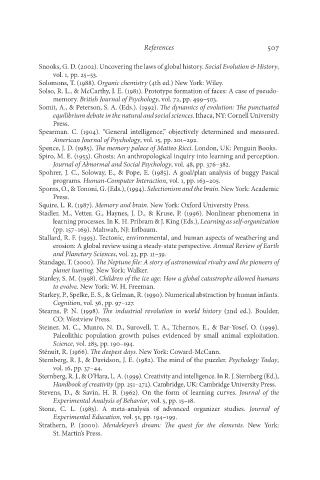Page 524 - Deep Learning
P. 524
References 507
Snooks, G. D. (2002). Uncovering the laws of global history. Social Evolution & History,
vol. 1, pp. 25–53.
Solomons, T. (1988). Organic chemistry (4th ed.) New York: Wiley.
Solso, R. L., & McCarthy, J. E. (1981). Prototype formation of faces: A case of pseudo-
memory. British Journal of Psychology, vol. 72, pp. 499–503.
Somit, A., & Peterson, S. A. (Eds.). (1992). The dynamics of evolution: The punctuated
equilibrium debate in the natural and social sciences. Ithaca, NY: Cornell University
Press.
Spearman. C. (1904). “General intelligence,” objectively determined and measured.
American Journal of Psychology, vol. 15, pp. 201–292.
Spence, J. D. (1985). The memory palace of Matteo Ricci. London, UK: Penguin Books.
Spiro, M. E. (1953). Ghosts: An anthropological inquiry into learning and perception.
Journal of Abnormal and Social Psychology, vol. 48, pp. 376–382.
Spohrer, J. C., Soloway, E., & Pope, E. (1985). A goal/plan analysis of buggy Pascal
programs. Human-Computer Interaction, vol. 1, pp. 163–205.
Sporns, O., & Tononi, G. (Eds.), (1994). Selectionism and the brain. New York: Academic
Press.
Squire, L. R. (1987). Memory and brain. New York: Oxford University Press.
Stadler, M., Vetter, G., Haynes, J. D., & Kruse, P. (1996). Nonlinear phenomena in
learning processes. In K. H. Pribram & J. King (Eds.), Learning as self-organization
(pp. 157–169). Mahwah, NJ: Erlbaum.
Stallard, R. F. (1995). Tectonic, environmental, and human aspects of weathering and
erosion: A global review using a steady-state perspective. Annual Review of Earth
and Planetary Sciences, vol. 23, pp. 11–39.
Standage, T. (2000). The Neptune file: A story of astronomical rivalry and the pioneers of
planet hunting. New York: Walker.
Stanley, S. M. (1998). Children of the ice age: How a global catastrophe allowed humans
to evolve. New York: W. H. Freeman.
Starkey, P., Spelke, E. S., & Gelman, R. (1990). Numerical abstraction by human infants.
Cognition, vol. 36, pp. 97–127.
Stearns, P. N. (1998). The industrial revolution in world history (2nd ed.). Boulder,
CO: Westview Press.
Steiner, M. C., Munro, N. D., Surovell, T. A., Tchernov, E., & Bar-Yosef, O. (1999).
Paleolithic population growth pulses evidenced by small animal exploitation.
Science, vol. 283, pp. 190–194.
Sténuit, R. (1966). The deepest days. New York: Coward-McCann.
Sternberg, R. J., & Davidson, J. E. (1982). The mind of the puzzler. Psychology Today,
vol. 16, pp. 37–44.
Sternberg, R. J., & O’Hara, L. A. (1999). Creativity and intelligence. In R. J. Sternberg (Ed.),
Handbook of creativity (pp. 251–272). Cambridge, UK: Cambridge University Press.
Stevens, D., & Savin, H. B. (1962). On the form of learning curves. Journal of the
Experimental Analysis of Behavior, vol. 5, pp. 15–18.
Stone, C. L. (1983). A meta-analysis of advanced organizer studies. Journal of
Experimental Education, vol. 51, pp. 194–199.
Strathern, P. (2000). Mendeleyev’s dream: The quest for the elements. New York:
St. Martin’s Press.

